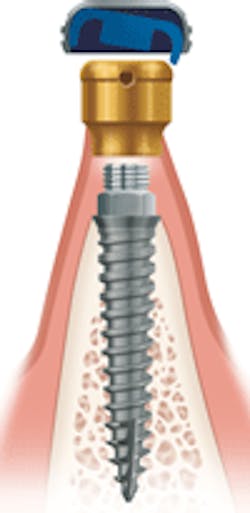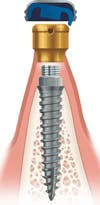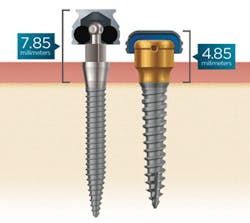Economic challenges present opportunities to use narrow diameter implants
exclusively designed for overdentures and the cost-conscious patient
by Paresh B. Patel, DDS
As health-care delivery costs increase and our dental patients age, the need to find a reliable and cost-effective solution for our edentulous patients becomes of utmost importance. Most dentists I speak with do not like to make dentures, instead referring these patients to other dentists. They often ask me, "How can you make any money for your practice with dentures?" I suggest that they explore the idea of incorporating narrow diameter implants (NDIs) into their practice of everyday dentistry.
The statistics are in, and they are not pretty. Today, there are more than 55 million denture wearers in the United States alone, and this number will continue to increase as 10,000 people a day turn age 65. Most of these edentulous patients have no regular dentist and should be presented with an affordable and efficient overdenture solution such as an NDI Overdenture with a LOCATOR® Attachment.
Why NDI Overdentures? Most patients with conventional dentures will tell you that they have learned how to "adapt" to their dentures as they have had these in their mouths for years. This way of thinking is not surprising. Put yourself in the dental chair for one moment; if two or three dentists told you that conventional dentures would be the best treatment option available for your particular scenario, you would have no choice but to figure out how to "adapt" to the situation, right? Imagine how happy you would be if you visited a new dentist who explained how you don't have to continue to live with conventional dentures. Wouldn't you, as the patient, likely say yes to that treatment, particularly if you didn't have a lot of downtime and it was cost-effective? Makes sense, right? So, now what? How do you get these patients into your practice? Hanging up a sign in your office saying "We offer implant-retained overdentures" is not going to be enough. Try visiting with your marketing team, a website designer, or a local newspaper representative to create a plan to educate your community that a solution now exists, at an affordable price, that can offer them the feel of their old denture but with the stability and security of being "snapped" into place.
Price. Of course, this is the million-dollar question for most patients. While an NDI-supported denture will cost more than a conventional denture, it does fill the void between the price of an implant overdenture with standard-size implants and one where the LOCATOR Attachment and retentive housings are included with the NDI. You can structure and present several treatment plans for better case acceptance. First, try presenting the overdenture with standard-size implants, if, of course, it is a viable option and there is available bone for placement. If adequate bone is not available, discuss the option of grafting or other surgical procedures with the patient. Finally, present the NDI Overdenture option, which is less expensive since the total investment in implants and attachments will be considerably less and bone grafting is not necessary. (Fig. 1)
I have had more than 12 years of success utilizing all treatment options to keep the patient in my practice. I strongly believe the narrow diameter implant-supported overdenture option is a vastly underutilized option that most surgically oriented dentists can provide. You should present all options that are viable solutions, not just ones that are in your capacity to provide.
Why LOCATOR Overdenture Implants? Choosing the correct narrow diameter implant is critical to the success of any overdenture case. The LOCATOR Overdenture Implant System (LODI) comes with the LOCATOR Overdenture Attachment that has a long history of being the primary attachment choice for clinicians worldwide. Other key benefits of this system include:
- A dramatically reduced vertical height. This provides patient comfort when the denture is removed as well as additional room for acrylic to strengthen the denture base as compared to O-ball attachments. (Fig. 2)
- The LOCATOR Male self-aligns and pivots inside the denture cap, providing a genuine resilient connection and ease of insertion for patients. (Fig. 3)
- Extremely durable retentive inserts that outlast Od-rings.
- LOCATOR Males and Extended Range Males offer multiple retention level options, 0-5 lbs., allowing you to select the ideal retention and accommodate for draw correction of divergent implants based on the number of implants placed and patient masticatory function.
- Two attachment cuff height options for implant placement flexibility.
- Two-piece design, allowing the attachment to be replaced should wear occur throughout time. (Fig. 1)
Overdenture chairside pick-up made safer and easier. One of the biggest fears dentists have is locking the overdenture permanently to the implant during chairside pick-up. With the use of new tissue-colored, low-heat materials, this can be avoided. This combination of self-curing pick-up material with light-cured pink composites (Quick-Up, VOCO America) to fill in voids makes for a complete system, reducing the stress clinicians may have when performing chairside techniques.
Incorporating NDI Overdentures into your practice can be a simple process. Take a course on how this treatment option can dramatically increase your production and improve your patients' lives. Once you begin your journey with implants and overdentures, you will soon become known in your community for providing this valuable service and your practice will reap the benefits.
Paresh B. Patel, DDS, is a graduate of the UNC-CH. He is the cofounder of the AAOSDI and enjoys helping dentists incorporate implant dentistry as everyday dentistry. Dr. Patel has placed more than 3,500 small-diameter implants. Contact him at [email protected] or www.aaosdi.com.
Past DE Issues



